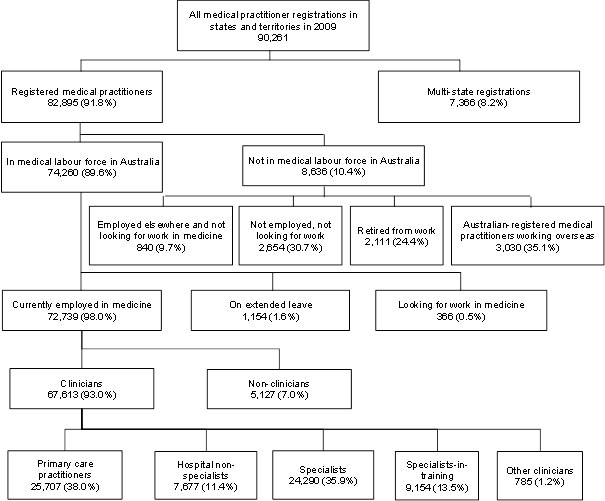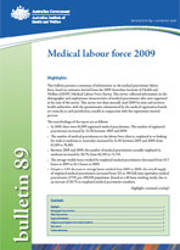Summary
This bulletin presents a summary of information on the medical practitioner labour force, based on estimates derived from the 2009 Australian Institute of Health and Welfare (AIHW) Medical Labour Force Survey. This survey collected information on the demographic and employment characteristics of medical practitioners who were registered at the time of the survey. This survey was done annually until 2009 by state and territory health authorities, with the questionnaire administered by the medical registration boards (or councils) in each jurisdiction, usually in conjunction with the registration renewal process.
The main findings of the report are as follows:
- In 2009, there were 82,895 registered medical practitioners. The number of registered practitioners increased by 22.1% between 2005 and 2009.
- The number of medical practitioners in the labour force (that is, employed in or looking for work in medicine in Australia) increased by 21.4% between 2005 and 2009, from 61,165 to 74,260.
- Between 2005 and 2009, the number of medical practitioners actually employed in medicine increased by 20.7%, from 60,252 to 72,739.
- The average weekly hours worked by employed medical practitioners decreased from 43.7 hours in 2005 to 42.2 hours in 2009.
- Despite a 3.4% decrease in average hours worked from 2005 to 2009, the overall supply of employed medical practitioners increased from 323 to 350 full-time equivalent medical practitioners (FTE) per 100,000 population (based on a 40-hour working week), due to an increase of 20.7% in employed medical practitioner numbers.
- Regionally, medical practitioner supply ranged from 392 full-time equivalent medical practitioners per 100,000 population in Major cities to 206 full-time equivalent medical practitioners per 100,000 population in Outer regional areas.
- The average age of employed medical practitioners in 2009 was 45.6 years, which was comparable with 2005, at 45.1 years.
- Females continued to increase their share of the medical practitioner workforce, making up 35.7% of employed practitioners in 2009 (up from 32.9% in 2005). Among clinicians, in 2009, the female share varied between types of clinical practice, accounting for 47.2% of hospital non-specialists, compared with 25.4% of specialists.
Figure 1: Registered medical practitioners, by labour force status, 2009

Source: AIHW Medical Labour Force Survey 2009.



